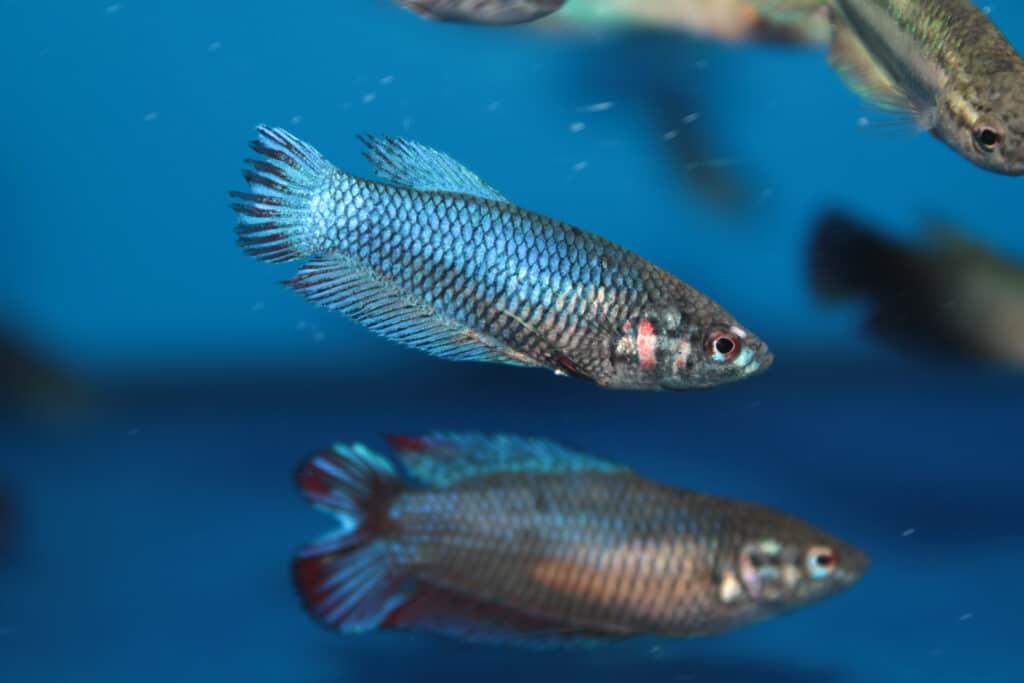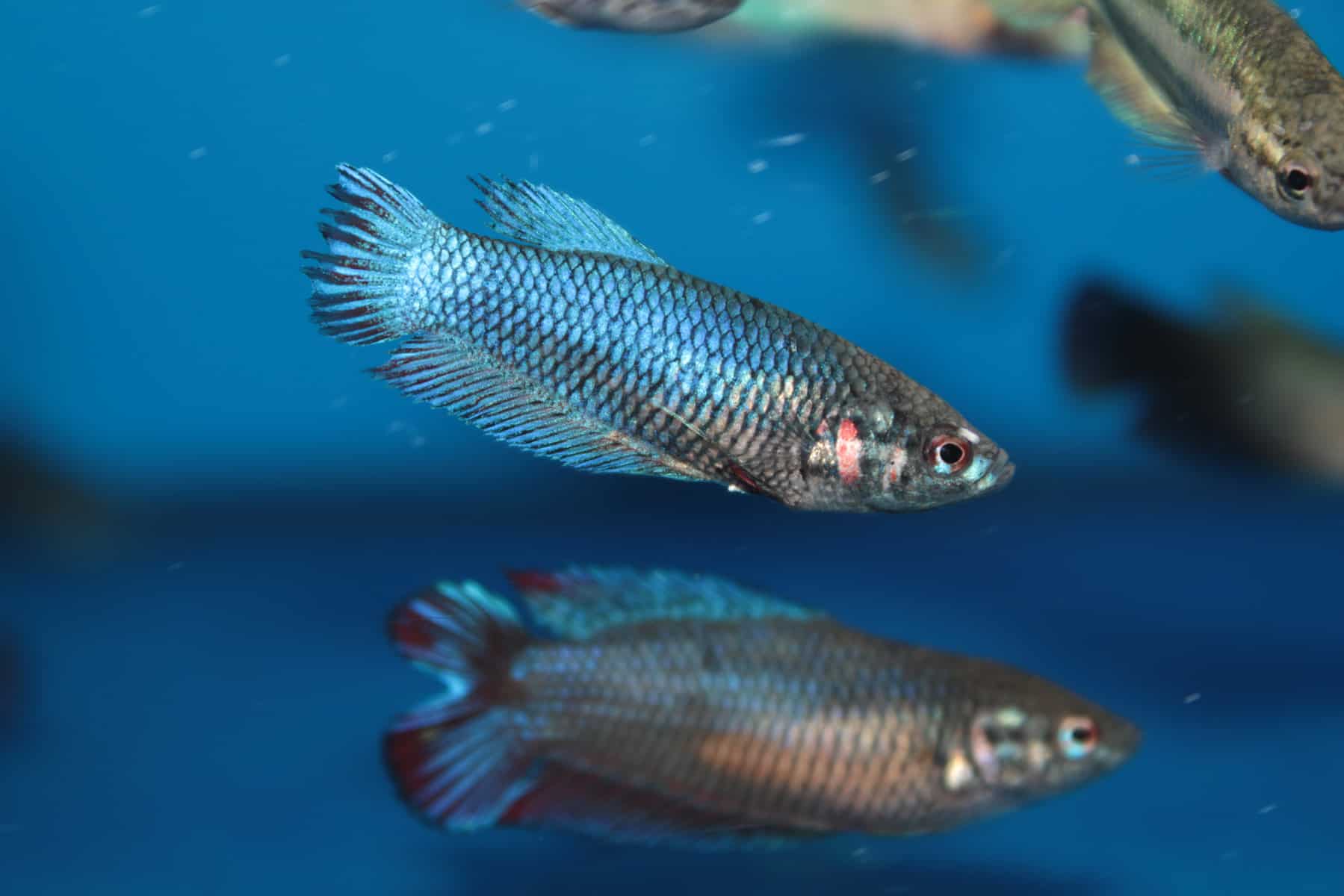If you’re seeking a more natural-looking betta, look no further than the Betta mandor. This wild-type fish is popular in the aquarium trade.
Unlike other bettas, these fish can live peacefully in pairs or groups when conditions are correct.
Before you invest — a Betta mandor can cost $35 to $65 and be hard to find — read our care guide to make sure you can support this vibrant but natural-looking fish.
What’s in a Name?
The Betta mandor gets its name from the waters in which it is found, the Mandor area in West Kalimantan on the island of Borneo.
Fish collectors capture the Betta mandor near two particular villages in the lower Kapuas River basin.
Each betta is classified and bred by the village to preserve the group’s purity, which means you can purchase either a pure Betta mandor (from the Mandor village) or a Betta mandor from the Anjungan breeding group (caught near the Anjungan village).
What Does a Betta Mandor Look Like?
A Betta mandor can have a black and blue body with red bars on its gills (typical of males) or a black and blue body with gold bars on its gills (characteristic of females).
These fish have shorter, more natural-looking tails and fins than other, more ornamental bettas, and large, robust bodies.
Fun fact: as a wild-type betta, a Betta mandor can also change its color with its mood.
Maximum Standard Length
On average, a Betta mandor is 50 to 60 millimeters long. This fish will be 2.25 inches or 5.7 centimeters long at its largest.
Sexual Dimorphism in the Betta Mandor
As stated above, a male Betta mandor is more likely to have red bars on his gills, and a female is more likely to have yellow or gold bars. Still, this is not a reliable indicator of gender.
Instead, look at the betta’s fins. A male Betta mandor will have longer fins than his female counterpart. Males are generally more colorful, as well.
Ultimately, the only way to be sure of a Betta mandor’s sex is to closely examine your fish and look for an “egg spot.” If the fish has an egg spot, you can rest assured she is female.
What Is a Betta Mandor’s Natural Habitat?
The Betta mandor lives in swamps and shallow streams thick with vegetation in the wild. The rainforest canopy above keeps the water warm and air moist while protecting fish from the hot sun.
The water a Betta mandor lives in is usually on the acidic side due to decaying vegetation.
Water Conditions to Mirror Your Betta Mandor’s Natural Habitat
To recreate ideal water conditions for your betta, give your fish at least five gallons of water to roam through, and fill their tank with plenty of decorations and live plants.
A Betta mandor appreciates soft, filtered water that is cool (but not cold) and mildly acidic. Keep the aquarium water between 72 and 83 degrees Fahrenheit and maintain a pH of 6 to 7.
Betta Mandor Maintenance
Maintaining a pleasurable tank for your Betta mandor is easy. Monitor your betta’s water to ensure it’s creating the ideal conditions for your fish, and introduce live plants and driftwood to give your fish places to hide.
Some Betta mandor keepers also introduce leaf litter to the tank because it creates a natural “soil” at the bottom and releases nutrients as it decomposes.
You can add aquarium gravel or another substrate if you wish, but most fish — and people — prefer to avoid this because it can make clean-up more difficult.
It all depends on how you want your tank to look, what’s best for your fishy friend, and how much work you want to do when cleaning your tank.
See our “Basic Guide to Cleaning Your Betta Fish Tank.”
Lighting
The last thing to consider for maintaining your Betta mandor tank is lighting. These rainforest-dwelling fish do not like intense lighting, so choose a soft bulb or filter the light with floating vegetation.
Like other types of betta, the Betta mandor has a labyrinth organ, so always leave room at the top of the tank to allow your fish to breathe the warm, humid air.
Betta fish can be trained, and the Betta mandor is an excellent jumper, so leaving space at the top of the tank can also lead to plenty of fun.
| Betta Mandor Info | |
|---|---|
| Common Names | Betta mandor |
| Scientific Name | Betta mandor |
| Minimum Tank Size | 5 gallons per pair |
| Beginner-friendly | No |
| Breeding | Difficult (males are mouthbrooders and may swallow eggs if stressed) |
| Lifespan | 2 to 4 years |
| Diet | Carnivorous and prefers a live diet |
| Aggressive | Territorial but can be kept in pairs or small groups |
| Water temperature | 72° to 83°F |
| pH level | pH 6 to 7 |
| Water hardness | 18 - 90 ppm |
Can My Betta Mandor Have a Friend?
Your Betta mandor is best kept alone, but if you plan to breed your fish, you can keep a male/female pair. Some keepers also have had success with one male and a small harem of females.
Never house two male bettas together, and be cautious with other, less dominant fish or companion species. This can upset your betta mandor or prevent a pair from breeding successfully.
Betta Mandor Behavior
Your Betta mandor might be a bit more shy and peaceful than other varieties of betta. Males may fight for mates, and every type of betta can be territorial, so you should still be cautious about introducing tank mates.
Remember that a Betta mandor is a wild betta variety, which means it is not bred for its ornamental fins and flashy behavior. It may act differently than other types of betta fish.
Still, many people like Betta mandor fish because they can sometimes be kept together, and their looks and behaviors are more subtle. For example, Mandor bettas usually are black, but they can flash blue when they are excited or upset.
Betta Mandor Breeding
Female Betta mandor fish usually initiate reproduction, and then it is up to the male to keep the eggs safe. Male Betta mandor fish are mouthbrooders, which means they incubate the eggs in their mouths and spit them out when they have hatched and can swim by themselves!
Each time Betta mandor fish “embrace,” the female releases eggs, and the male collects them in his mouth. The fish will continue this cycle until the female has no eggs left.
Because male Betta mandor fish will swallow their eggs if they get stressed, breeders often house mandor pairs in a separate tank to eliminate stressors and keep things under control.
Male betta fish may also need space from eager females, so the fish should be separated from time to time to allow both of them to eat and rest between spawning sessions.
For “fry” (baby bettas) to develop, the breeder will also need to maintain certain conditions, such as warm, humid water at the top of the tank to help the babies develop their labyrinth organs, as well as nutrients in the water from live plants and decaying leaves.
Some breeders keep tightly sealed plastic wrap over their breeding tanks to ensure baby bettas get the right air.
What Should I Feed My Betta Mandor?
In the wild, Betta mandor eat insects, other small invertebrates, and plankton. Most breeders feed their mandor live insects in captivity, so they may be picky eaters when you first buy them, but you can train them to eat frozen and dried foods if you prefer.
As soon as the betta recognizes something in its tank as food, it will not hesitate to eat it!
Betta Mandor Diet
Betta mandor fish are strictly carnivorous.
A balanced Betta mandor diet includes live blackworms, frozen bloodworms, and any naturally-occurring microorganisms you grow in your tank. Many breeders also feed their Mandor bettas live crickets and fruit flies.
For best results and maximum nutrition, give live insects fruit or vegetables before feeding them to your betta.
Careful: the Betta Mandor Is Prone to Obesity!
Once the Betta mandor gets familiar with its food and its source of food (you!), it will eat whatever you put in the tank.
Be careful not to overfeed your betta, as this variety of betta fish is prone to obesity.
Remember, your fish cannot sense when it is full, so regular, controlled portions are best. To avoid overfeeding and dirtying your tank, remove any uneaten food immediately.
Bettas That Are Similar to the Betta Mandor
People on Reddit compare Betta mandor to Betta rubra and Betta persephone, and some breeders compare them to Betta foerschi.
Betta Mandor vs. Betta Foerschi
Betta mandor and Betta foerschi are both endemic to Borneo. The fish are very similar, but Betta mandor are typically larger and have slightly different coloring.
Betta Mandor vs. Betta Rubra
Betta mandor and Betta rubra are both mouthbrooders that are great at jumping. However, Betta rubra fish are ruby red, and Betta mandor are black (or blue, depending on their mood).
Betta rubra can also be more difficult to find.
Betta Mandor vs. Betta Persephone
Betta persephone are critically endangered and should not be captured and kept as pets. Captive fish are rare and highly sought after.
Betta mandor and Betta persephone may have similar colors and temperaments, but Betta persephone live in the Ayer Hitam Peat Swamp Forest Reserve in Muar, Johor, Malaysia, whereas Betta mandor live in Borneo.
Where Can I Get a Betta Mandor?
You will need to contact a specialty breeder to acquire a Betta mandor. Be aware that these fish are frequently sold out, and you may need to join a waitlist to purchase one.
Many varieties of betta are decreasing, especially wild-type bettas. Wild bettas are losing their natural habitats to logging, pollution, and other harmful human activity, making them harder to maintain in captivity.
When purchasing your Betta mandor, make sure you are working with an ethical breeder.
You don’t want to buy a wild Betta mandor because they are endangered and should not be removed from their natural habitats, but you will still want to buy a domestic betta whose traits have been preserved.
Caring for Your Betta Mandor: A Summary
Before you buy your Betta mandor, make sure you are ready to care for your new fishy friend(s).
- Choose from a Betta mandor from Mandor or from the Anjungan breeding group.
- Know whether you will be purchasing a male, a female, a breeding pair, or a small group, and prepare your tank appropriately (every breeding pair needs at least a 5-gallon tank, and bigger is always better).
- Set up your tank beforehand with the correct temperature, filtration, acidity, and softness. Having the correct water conditions is important.
- Don’t forget live plants, driftwood for hiding, floating vegetation for filtered light, and natural substrate (leaf litter) for nutrients. These elements will mirror your Betta mandor’s natural habitat.
- Prepare a balanced Betta mandor diet and feeding schedule for your fish. You may want to order frozen worms or buy live insects and feed them plenty of fruits and vegetables so they are ready to become meals for your betta.
- Don’t expect an aggressive, ornamental betta like the ones you might find at your local pet store. Betta mandor have unique temperaments.
- Choose the betta that’s best for you, and start looking for a breeder as soon as possible because some varieties can be hard to find.
- Get ready to train and bond with your new fishy friend.
If you are setting up your Betta mandor’s new home, you might find these resources from Betta Source valuable:

